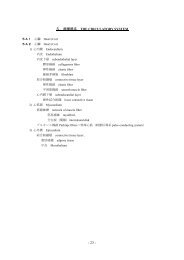Program / Abstract Book - KMU WWW3 Server for Education ...
Program / Abstract Book - KMU WWW3 Server for Education ...
Program / Abstract Book - KMU WWW3 Server for Education ...
You also want an ePaper? Increase the reach of your titles
YUMPU automatically turns print PDFs into web optimized ePapers that Google loves.
No. 32 (PI 6)<br />
Discrepancy between serologic and genotyping results of ‘Mi a ’ blood antigen and<br />
antiserum in Taiwan<br />
Chien-Feng Sun 1,2 , Tai-Di Chen 2 , Ding-Ping Chen 2<br />
1 Department of Anatomic Pathology, 2 Department of Laboratory Medicine, Linkou Medical Center,<br />
Chang Gung Memorial Hospital, Taoyuan, Taiwan<br />
Aim. Mi.Ⅲ (GP.Mur) is reported to have a mean frequency of 7.3% among Taiwanese. Since the<br />
specificities of Mi.III (GP.Mur) antisera are not further specified, such antisera and the cells identified<br />
by them have been applied a collective term as anti-‘Mi a ’ and ‘Mi a ’(+) cells in Taiwan. Anti-‘Mi a ’<br />
antibodies are the most common clinically important antibodies detected in Taiwan. Our aim of this<br />
study is to evaluate the efficiency of current practice of using ‘Mi a ’(+) screening cells in comparing to<br />
genotyping <strong>for</strong> Miltenberger series.<br />
Materials and Methods. Blood samples were obtained from randomly selected patients. Antisera<br />
containing anti-‘Mi a ’ specificity were collected routinely in our blood bank. Manual polybrene method<br />
without a supplementary antiglobulin phase was used <strong>for</strong> serologic test. The results of serologic test<br />
were compared with PCR-sequencing data. The study was approved by our Institutional Review Board.<br />
Results. The prevalence of Mi.Ⅲ(GP.Mur) is 6.4% (25/389). Among 1945 serologic tests <strong>for</strong> these<br />
389 samples, 210 tests showed a positive reaction (1+ or more). Among them, only 84 positive results<br />
belonged to PCR (+) samples. The sensitivity and specificity of our routine practice using ‘Mi a ’(+)<br />
screening cells to detect anti-‘Mi a ’ antibodies are thus estimated to 67.2% (84/125) and 93.1%<br />
(1694/1820), respectively. The positive predictive value is 40% (84/210).<br />
Conclusions. Our results showed that the Mi.III (GP.Mur) has a prevalence of 6.4% in Taiwan, and no<br />
GP.Hut, GP.Hop, GP.Bun, or GP.HF was detected. However, our study also showed that our screening<br />
system <strong>for</strong> detecting anti-‘Mi a ’ has a low sensitivity of 67.2% with a specificity of 93.1%. Since a<br />
previous study suggested the presence of other glycophorin variants in Taiwan, the results suggested the<br />
existence of other (Mi) phenotypes and the current detecting method may not be sufficient to identify<br />
antibodies other than anti-GP. Mur.<br />
- 85 -



